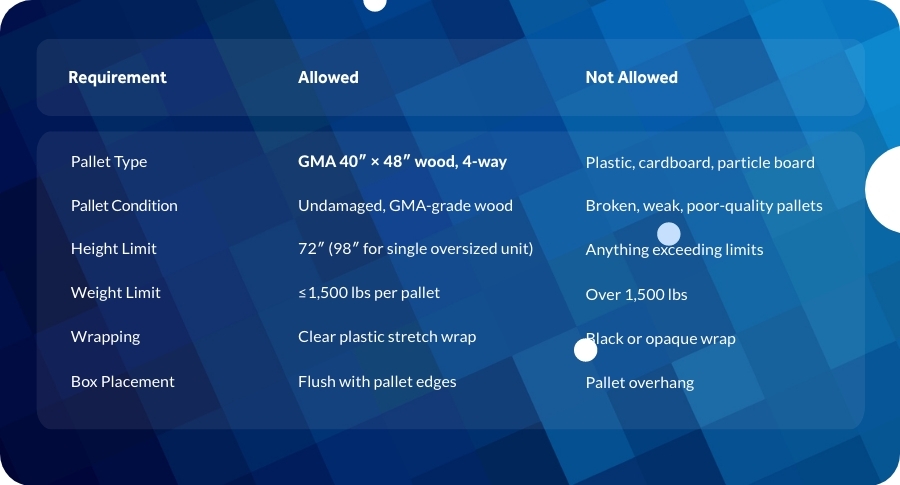
Shipping pallets into Amazon fulfillment centers is essential for businesses looking for viable long-term success with the eCommerce giant. The process for doing so, however, is not as straightforward as that of sending parcel shipments. Amazon has strict requirements for pallet dimensions, wrapping, labeling, and load stability. Failure to meet them can result in costly rejections, delays, and even chargebacks.
For Canadian sellers, following these rules is especially important as shipments pass through warehouses, each with their own handling standards. Whether you’re sending your first LTL shipment or scaling with FTL loads, knowing Amazon’s pallet requirements in Canada will save you time, money, and frustration.
This guide breaks down everything you need to know - from pallet size and material requirements to wrapping, labeling, and common mistakes to avoid, so you can ship with confidence and keep your Amazon business running smoothly.
1. What Ships by Pallet (LTL, FTL, FCL)?
Customers should use pallet shipments when:
- Their shipment exceeds 150 lbs, contains more than 20 boxes, or fills an entire truck.
- Amazon supports Less-Than-Truckload (LTL) and Full-Truckload (FTL) shipments through designated routing.

2. Pallet Specifications: Size, Material & Quality
-
Size: Pallets must be 40″ × 48″ GMA standard with 4-way forklift entry.
-
Material: Must be wooden pallets only—plastic, cardboard, or particle board pallets are not accepted.
-
Quality Grades:
-
General goods → GMA Standard B Grade
-
Grocery → GMA 1A Grade
-
Health/Beauty/Personal Care → GMA 1A or 1B Grade
-
-
Condition: Poor-quality or damaged pallets are strictly prohibited.
3. Height & Weight Restrictions
-
Maximum Height: 72 inches including pallet base.
-
Oversized Exception: Up to 98 inches only if shipping a single, non-stackable oversized unit.
-
Maximum Weight: 1,500 lbs per pallet.
4. Building Your Pallet: Stacking & Stability
-
Stacking: Use brick stacking, or alternating patterns on each layer, with heavy boxes at the bottom. Boxes must be flush with pallet edges—pallet overhang is not permitted.
-
Single-ASIN Pallets: Stack boxes uniformly.
-
Mixed-ASIN Pallets: Must be physically separated for clarity.

5. Pallet Wrapping & Labeling
-
Stretch Wrap: Only clear plastic stretch wrap is allowed. Black or opaque stretch wrap is prohibited.
-
Stability: Wrap securely to keep cartons from shifting.
-
Labels: 4 pallet labels (one clearly visible on each side). Each box must also have an FBA box ID label.
6. Clearances & Spacing
-
Roof Clearance: Leave 6 inches between top of pallet and trailer/container ceiling.
-
Between Pallets: Maintain 3 inches spacing for safe forklift handling.
7. International Standards: Wooden Packaging Rules
If you are importing pallets into Canada, ensure they meet CFIA and ISPM-15 requirements. Look for the IPPC wheat stamp on pallets. Non-wood options like plastic or corrugated may be ISPM-15 exempt, but Amazon does not accept these pallet types.
8. Common Errors That Cause Rejections
- Plastic pallets → Not accepted.
- Black stretch wrap → Not accepted.
- Poor-quality or damaged pallets → Not accepted.
- Pallets exceeding height restrictions → Not accepted.
- Pallet overhang → Not accepted.
9. Quick Reference Table

10. Final Thoughts
Amazon fulfillment centre pallet requirements may seem especially strict. They are strict, however, because unsafe or non-compliant pallets disrupt warehouse efficiency. Sellers who ignore pallet rules risk rejections, delays, and chargebacks. By following Amazon Canada’s requirements - using the correct wooden pallet, keeping shipments within height/weight limits, using clear stretch wrap, and ensuring no overhang – you can ensure smooth check-in and faster replenishment.
For more information, you can also refer to the official Amazon Seller Central Pallet Requirements here.
At Freightcom, we understand that compliance is more than a box to check, it’s the difference between seamless delivery and costly disruptions. That’s why we provide Canada’s most complete shipping platform.
Whether you’re preparing your first Amazon pallet shipment or managing high-volume FBA freight, Freightcom makes it simple. We partner with over 50 of the most trusted carriers in North America to provide real-time discounted rates on a wide range of LTL, FTL, and parcel services with zero upfront or monthly fees!
Contact one of our shipping experts today and see how Freightcom can help you ship smarter wherever, and whatever you need to ship.


.png?width=250&height=58&name=MicrosoftTeams-image%20(28).png)